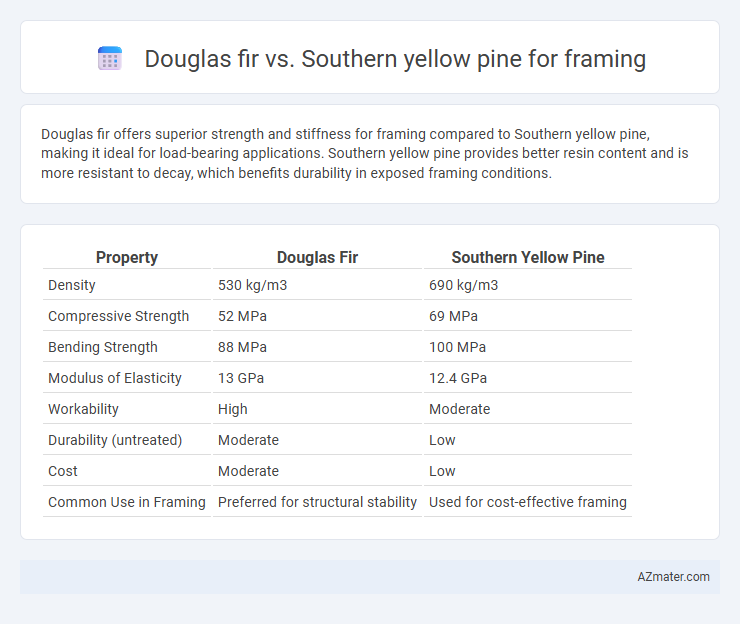Douglas fir offers superior strength and stiffness for framing compared to Southern yellow pine, making it ideal for load-bearing applications. Southern yellow pine provides better resin content and is more resistant to decay, which benefits durability in exposed framing conditions.
Table of Comparison
| Property | Douglas Fir | Southern Yellow Pine |
|---|---|---|
| Density | 530 kg/m3 | 690 kg/m3 |
| Compressive Strength | 52 MPa | 69 MPa |
| Bending Strength | 88 MPa | 100 MPa |
| Modulus of Elasticity | 13 GPa | 12.4 GPa |
| Workability | High | Moderate |
| Durability (untreated) | Moderate | Low |
| Cost | Moderate | Low |
| Common Use in Framing | Preferred for structural stability | Used for cost-effective framing |
Introduction: Comparing Douglas Fir and Southern Yellow Pine for Framing
Douglas Fir offers high strength-to-weight ratio and excellent dimensional stability, making it a preferred choice for structural framing. Southern Yellow Pine boasts superior density and hardness, providing robust load-bearing capacity and resistance to wear. Both species deliver reliable performance in framing, with Douglas Fir favored for precision and Southern Yellow Pine for heavy-duty applications.
Wood Density and Strength Characteristics
Douglas fir has a wood density of approximately 530 kg/m3 and exhibits a high strength-to-weight ratio, making it ideal for framing where durability and load-bearing capacity are critical. Southern yellow pine, with a higher density around 720 kg/m3, offers superior compression and bending strength, providing excellent structural support in heavy-duty framing applications. Both species are preferred for framing due to their strength characteristics, but Southern yellow pine's greater density typically results in enhanced stiffness and resistance to deformation under load.
Structural Performance in Framing Applications
Douglas fir exhibits superior strength-to-weight ratio and stiffness compared to Southern yellow pine, making it ideal for load-bearing framing applications where structural integrity is critical. Southern yellow pine offers higher density and hardness, providing excellent resistance to deformation and impact, which enhances durability under heavy structural loads. Both species perform well in framing, but Douglas fir is preferred for its consistent dimensional stability and ability to span longer distances without compromising strength.
Moisture Resistance and Durability
Douglas fir offers superior moisture resistance and durability compared to Southern yellow pine, making it a preferred choice for framing in environments with higher humidity or exposure to moisture. Its tight grain structure and natural oils help reduce susceptibility to rot and decay, extending the lifespan of framed structures. Southern yellow pine, while strong and widely available, tends to absorb more moisture and requires additional treatment to achieve comparable durability and resistance to fungal attacks.
Workability and Ease of Handling
Douglas fir offers superior workability and ease of handling for framing due to its straight grain and uniform texture, allowing for cleaner cuts and smoother nailing. Southern yellow pine, while denser and harder, requires more effort when cutting or nailing but provides excellent strength and nail-holding capabilities. Both are popular framing choices, with Douglas fir preferred for ease of use and Southern yellow pine favored for its robustness under heavy loads.
Cost Differences and Market Availability
Douglas fir typically commands a higher price than Southern yellow pine due to its superior strength and durability, making it a preferred choice for high-quality framing projects. Southern yellow pine offers greater market availability and lower cost, benefiting builders seeking budget-friendly options with acceptable performance. Regional factors greatly influence price fluctuations, but Southern yellow pine consistently provides more accessible supply and cost savings in most U.S. markets.
Sustainability and Environmental Impact
Douglas fir is favored for framing due to its faster growth rate and ability to be sustainably sourced from well-managed forests, reducing environmental impact. Southern yellow pine, while abundant and strong, often comes from regions with slower reforestation rates, which can strain ecosystems if not responsibly harvested. Both species offer renewable wood options, but Douglas fir's sustainable forestry certifications and lower carbon footprint make it a more environmentally responsible choice for framing projects.
Regional Suitability and Sourcing
Douglas fir is widely preferred in the Western United States for framing due to its abundant regional availability, strength, and dimensional stability, making it a top choice for Pacific Northwest construction projects. Southern yellow pine, sourced predominantly from the Southeastern United States, offers exceptional hardness and load-bearing capacity, aligning with the needs of builders in that region where it is readily accessible and cost-effective. Regional sourcing of these species directly impacts framing costs and sustainability, as local availability reduces transportation expenses and environmental footprint.
Common Building Code Considerations
Douglas fir offers superior strength and stiffness compared to Southern yellow pine, making it a preferred choice for framing according to most building codes such as the International Residential Code (IRC). Southern yellow pine, while slightly less dense, meets code requirements for load-bearing capacity and is often treated for enhanced resistance to decay and insects, aligning with standards for durability. Both species comply with span tables and grading rules under ASTM D2555, but Douglas fir's higher modulus of elasticity typically allows for longer spans and reduced deflection in structural applications.
Conclusion: Choosing the Right Lumber for Your Project
Douglas fir offers superior strength, stability, and resistance to warping, making it ideal for high-load structural framing projects. Southern yellow pine provides excellent hardness and stiffness, often preferred for its affordability and widespread availability in residential framing. Selecting the right lumber depends on project requirements, budget considerations, and environmental conditions, with Douglas fir favored for premium durability and Southern yellow pine for cost-effective, versatile applications.

Infographic: Douglas fir vs Southern yellow pine for Framing
 azmater.com
azmater.com